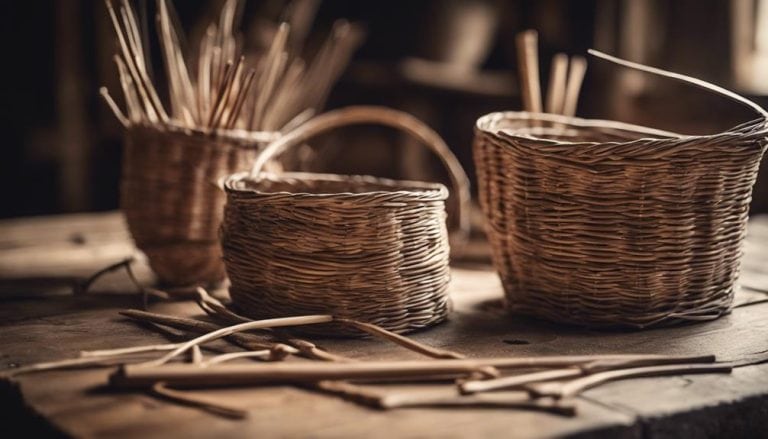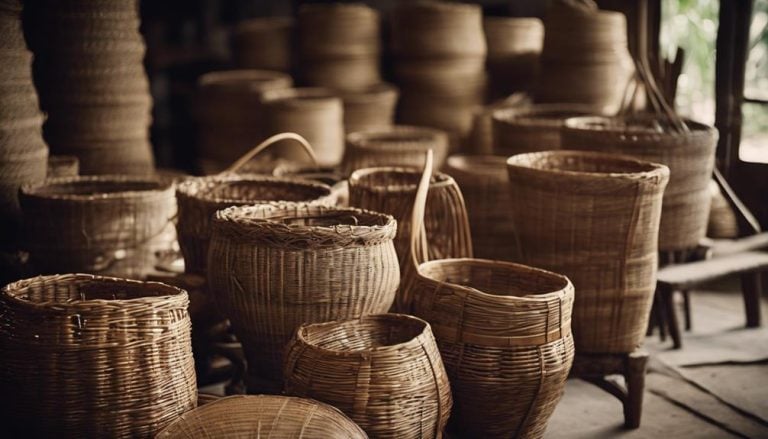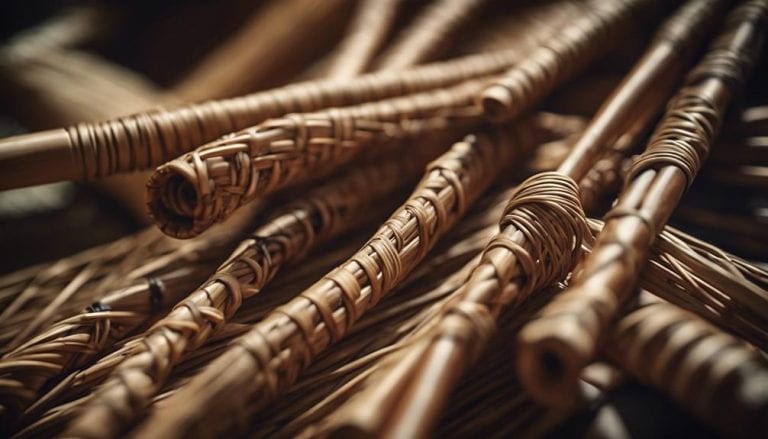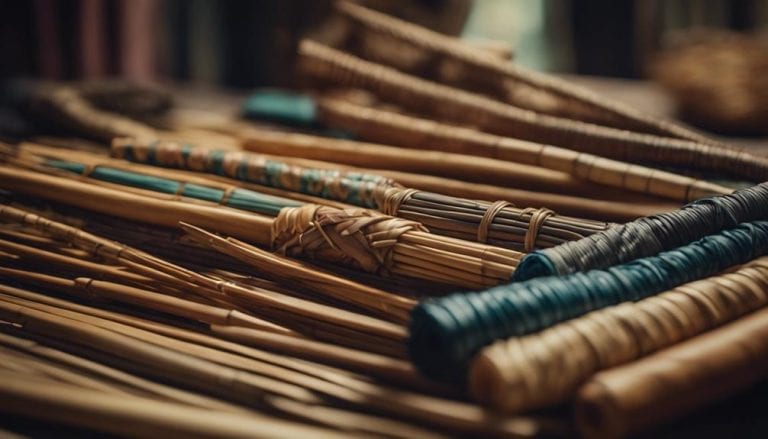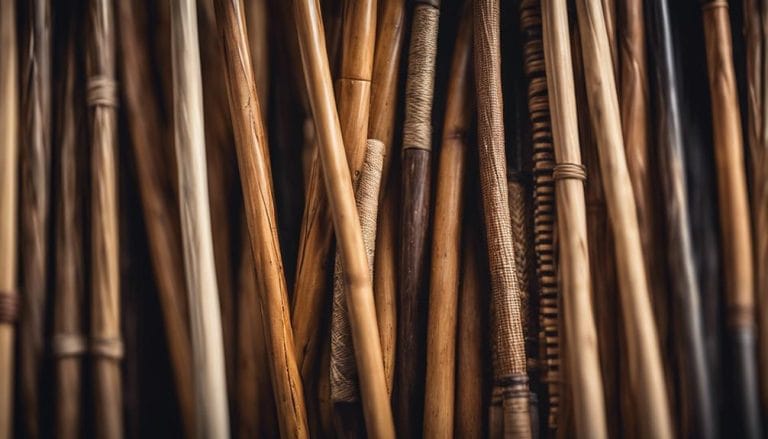Rattan Cane for Weaving: Tips and Tricks
When I first tackled weaving a rattan chair seat, I underestimated the importance of properly preparing the cane. It’s a step many beginners overlook, but it makes all the difference in the durability and appearance of the final product. Since then, I’ve learned a lot, from selecting the right materials to mastering intricate weaving patterns. In this discussion, I’ll share some essential tips and tricks that have transformed my approach to working with rattan cane. Let’s explore how these insights can elevate your weaving projects to the next level, ensuring beauty and longevity.
For weaving with rattan cane, ensure proper soaking for flexibility and use a weaving pattern to create sturdy, beautiful designs. Experiment with different techniques and patterns for unique creations with rattan cane.
Key Takeaways
- Soak rattan cane in warm water to enhance flexibility for easier weaving.
- Use sharp knives and round-nosed pliers for precise shaping and bending.
- Master weaving patterns such as randing and slewing for diverse and durable designs.
- To ensure longevity, maintain rattan furniture by regularly cleaning it, protecting it from sunlight, and storing it properly.
Preparing Your Rattan Cane
Before diving into the art of rattan cane weaving, it’s crucial to properly prepare your materials, ensuring they’re pliable and ready to transform into your next masterpiece. Soaking techniques play a pivotal role in this preparation phase. I’ve found that immersing rattan cane in warm water significantly increases its flexibility, making it much more amenable to intricate designs. Cutting the cane into manageable lengths, typically not exceeding 3 yards, facilitates easier handling and manipulation during weaving.
Once soaked, I meticulously wipe each strand dry and work it between my fingers, ensuring it’s supple and ready for weaving. This tactile engagement connects me to my craft and allows me to gauge the rattan’s readiness for weaving. To maintain this perfect level of flexibility, I hang the prepared cane on a hook, covering it with a damp cloth. This simple yet effective maintenance tip keeps the cane in prime condition throughout the weaving process.
Keeping the rattan damp during the weaving is key to preventing it from drying out and becoming brittle. I frequently use a wet cloth, gently applying it to the cane. This intimate interaction with the material ensures that my creations are beautiful but also durable and long-lasting.
Essential Weaving Tools
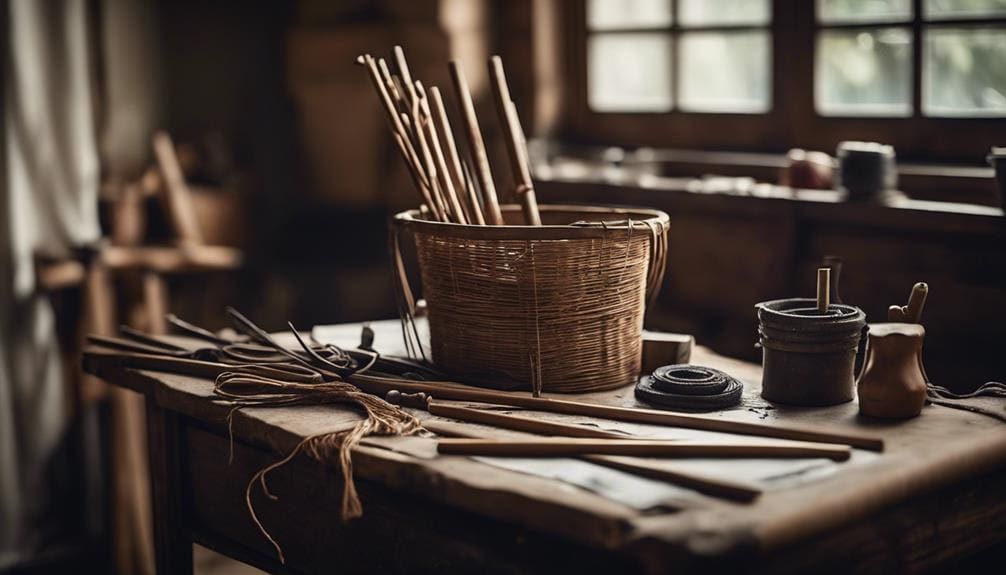
After preparing your rattan cane, selecting the right tools is crucial for bringing your weaving projects to life. My journey with rattan weaving taught me the importance of each tool in my kit. A sharp knife isn’t just a cutting tool; it’s an artist’s brush that shapes and defines the cane’s form. Mastering knife techniques allowed me to craft intricate designs precisely, transforming raw cane into a tapestry of patterns and textures.
Peg placement is another critical aspect of weaving. It’s not merely about securing the cane; it’s about creating a stable foundation that guides the rhythm of your work. I’ve learned to position pegs strategically, ensuring each piece of cane is held firmly yet has enough flexibility for weaving. Equally, round-nosed pliers have become an extension of my hands, bending and twisting the cane into delicate curves. The awl, a simple yet essential tool, makes piercing the base material effortless, allowing the rattan to be woven seamlessly.
Tools like bodkins and the rapping iron have refined my weaving process. They help tighten the weave and shape the cane, which is essential for the durability and beauty of the final piece. Each tool plays a pivotal role in the art of rattan weaving, turning simple cane into exquisite works of art.
Common Weaving Patterns

Delving into rattan weaving, I’ve discovered that mastering common patterns like railing, Pairing, Slewing, Waling, and Braiding is essential for crafting intricate and durable pieces. Each technique, with its unique rhythm and flow, has become a language through which I express my artistic vision. With its horizontal dance, Randing lays the foundation of my work, ensuring a sturdy and even canvas. It’s fascinating how this simple technique, rooted in historical origins, remains a cornerstone for both traditional and modern variations of rattan creations.
Pairing, on the other hand, introduces me to the art of strength. Weaving two strands in parallel, I marvel at the added durability it brings to my creative projects, an advanced technique that underscores the importance of unity. Slewing has always been a mesmerizing spell for me. Twisting the cane, I watch as a textured pattern emerges, bringing a unique character to each piece. It’s a testament to how advanced techniques can breathe life into rattan, transforming it into a medium of expression.
With its diagonal grace, Waling adds layers of complexity and visual interest. It’s a dance of direction that challenges and excites me, pushing the boundaries of my creativity. In the realm of rattan weaving, these patterns are my tools for storytelling. They blend historical wisdom with my personal touch, crafting pieces that speak of both tradition and innovation.
Crafting a Split Cane Stool
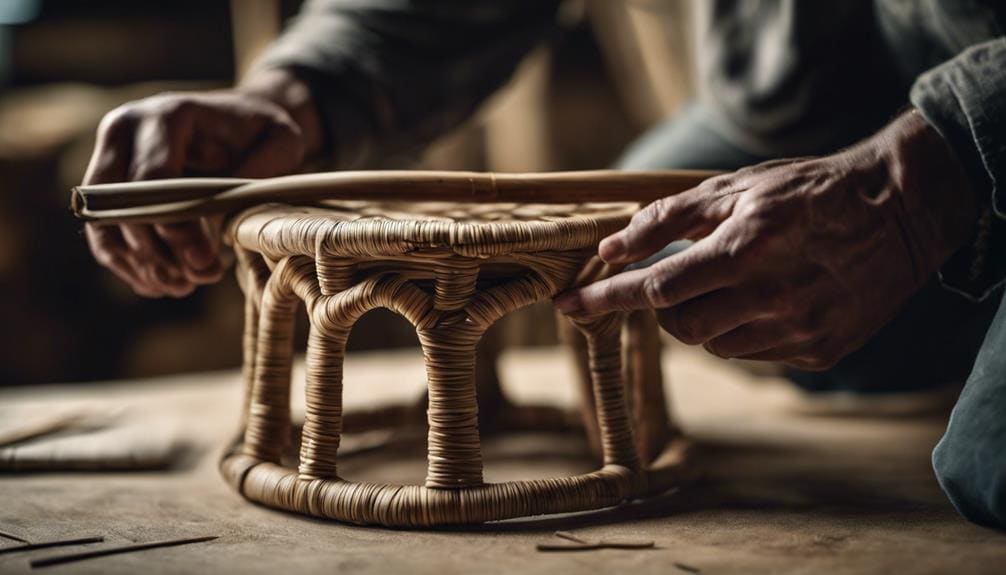
Having explored the foundational weaving patterns, I now set my sights on a practical application by crafting a split cane stool. This project marries simplicity with the elegance of traditional techniques. This venture into cane furniture tests my talent and allows me to connect deeply with the craft.
Creating a rattan chair or stool from split cane material involves a meditative process, where each strand tells a story of resilience and beauty. The tactile sensation of weaving, the rhythmic passing of cane through wood, is an intimate dance between maker and material.
| Step | Detail |
|---|---|
| 1 | Select a wooden base with pre-drilled holes. |
| 2 | Prepare the split cane by soaking it to enhance flexibility. |
| 3 | Begin weaving the cane through the holes, securing it tightly. |
| 4 | Adjust tension to ensure evenness and strength in the weave. |
| 5 | Finish by trimming excess cane and tucking in the ends. |
This tableau of steps simplifies the complexity behind crafting a split cane stool, a cornerstone of traditional cane furniture. Through this project, I mastered the basics of weaving and paid homage to a timeless art form.
Weaving a Chair Seat and Back

I now focus on the intricate art of weaving chair seats and backs, employing high-quality rattan cane to ensure each piece showcases its beauty and stands the test of time. Mastering this craft demands patience and a keen eye for detail, qualities I’ve honed over years of practice.
Opting for traditional techniques, I often weave using the hexagonal weave or herringbone pattern. Each offers a classic look that’s both attractive and durable. The choice between these two depends on the aesthetic I aim to achieve; the hexagonal weave provides a timeless elegance, while the herringbone pattern introduces a subtle complexity to the design.
To ensure the rattan cane remains firmly in place, I use pegs, securing them strategically to maintain even tension throughout the weave. This step is crucial for a professional finish. Instead of a rapping iron, which I find too harsh on the delicate rattan, I’ve adapted to using a blunted chisel or protective tape. This innovative approach protects the cane while allowing me to tighten the weave effectively.
Caring for Rattan Creations
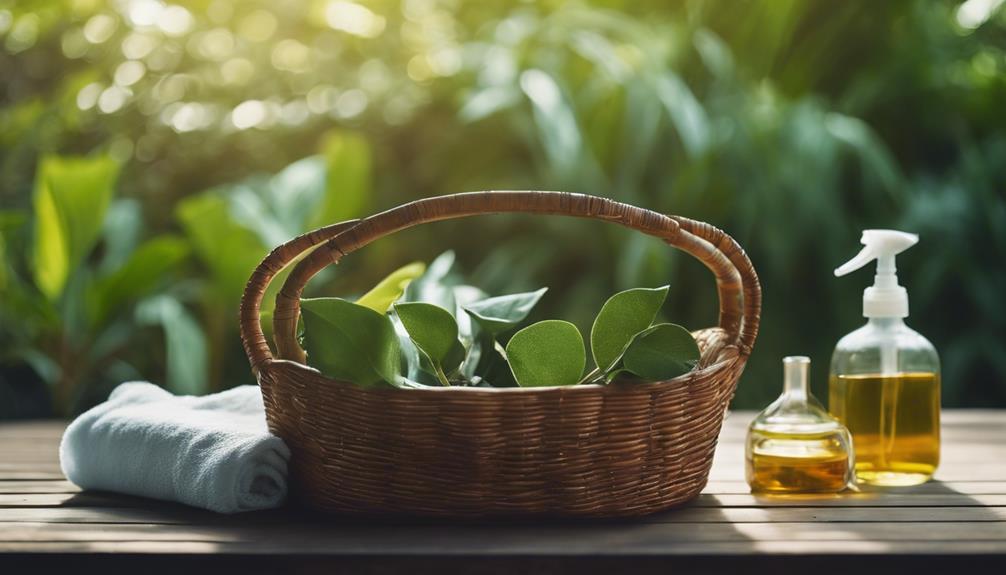
Caring for your rattan creations ensures they retain their beauty and durability for years. As an artist who has spent countless hours weaving and shaping rattan into intricate designs, I’ve learned the importance of proper maintenance. Here, I’ll share some cleaning techniques and maintenance tips to keep your pieces pristine.
To start, avoid prolonged exposure to direct sunlight. The harsh rays can fade and dry out your rattan, robbing it of its natural luster. Instead, place your creations where they can bask in indirect light, preserving their warmth and depth of color.
For regular upkeep, here’s what I recommend:
- Dust regularly with a soft cloth or vacuum with a brush attachment to remove debris.
- Clean with a damp cloth using a mild detergent, and ensure it’s completely dry to prevent mold.
- Apply a thin coat of linseed oil or furniture polish to maintain flexibility and shine.
Lastly, store your rattan furniture in a dry, well-ventilated area. This precaution prevents moisture damage and prolongs the lifespan of your beloved pieces, allowing them to remain a testament to your artistic dedication and care.
Frequently Asked Questions
How Long to Soak Rattan Before Weaving?
Soaking my rattan for about 30 minutes in warm water does the trick. Make sure it’s fully submerged in your soaking container for even flexibility. It’s a game-changer for my weaving projects.
How Do You Prepare Rattan for Weaving?
I start by carefully selecting my rattan, ensuring it’s high quality. After soaking it, I use specific drying techniques to maintain its flexibility. This preparation is crucial for my weaving to turn out beautifully.
How Can I Make My Rattan More Flexible?
I increase my rattan’s moisture content by soaking it in warm water to make it more flexible. Then, I use heating methods like a hairdryer to add flexibility, ensuring it’s always moist and pliable.
Why Do You Soak Cane Webbing?
I soak my cane webbing to unlock its hidden flexibility, ensuring cane preservation and a flawless finish. This ritual transforms stiff fibers into pliable threads, perfect for weaving, surpassing any webbing alternatives.
Conclusion
As I wove the final strand of rattan into my latest chair, a serendipitous realization struck me: the beauty of weaving lies not just in the patterns we create but in the journey of transformation. Each piece, from a simple stool to a complex chair back, tells a story of patience and skill. Caring for these creations is akin to nurturing a piece of art. With the right tools and dedication, the rattan’s humble beginnings morph into enduring symbols of craftsmanship. This journey, steeped in tradition and innovation, is a testament to the weaver’s art.


